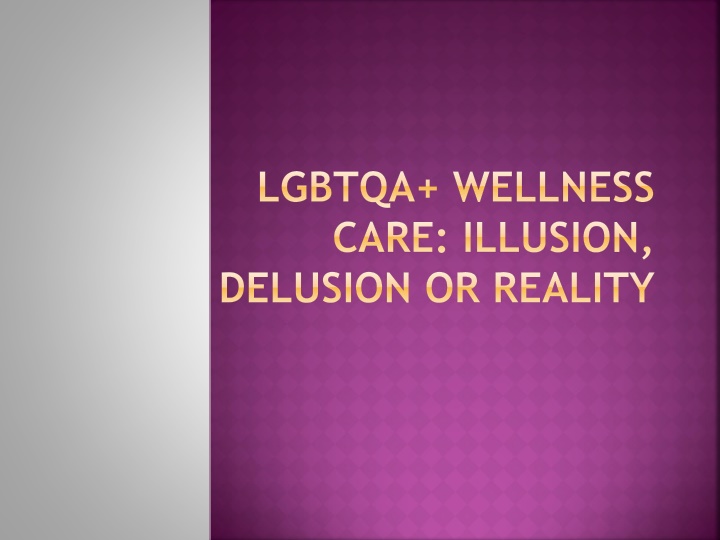
Understanding LGBTQA+ Wellness Care Challenges and Social Construction
Explore the complexities of LGBTQA+ wellness care, societal challenges, and the impact of social construction on perceptions of reality. Gain knowledge to advocate for change and provide quality care for the LGBTQA+ community in this comprehensive learning experience. Navigate intersections of identities and address various aspects such as sexual orientation, gender identity, and terminology to enhance inclusivity and understanding.
Download Presentation

Please find below an Image/Link to download the presentation.
The content on the website is provided AS IS for your information and personal use only. It may not be sold, licensed, or shared on other websites without obtaining consent from the author. If you encounter any issues during the download, it is possible that the publisher has removed the file from their server.
You are allowed to download the files provided on this website for personal or commercial use, subject to the condition that they are used lawfully. All files are the property of their respective owners.
The content on the website is provided AS IS for your information and personal use only. It may not be sold, licensed, or shared on other websites without obtaining consent from the author.
E N D
Presentation Transcript
LGBTQA+ WELLNESS CARE: ILLUSION, DELUSION OR REALITY
LEARNING OUTCOME An increase in participants knowledge of the challenges the LGBTQA+ population faces in health care and society as well as knowledge of how to successfully move forward. This increase in knowledge will allow participants to better advocate for change at the individual, societal, and population levels and serve in providing quality care for those who identify as LGBTQA+.
SOCIAL CONSTRUCTION ANYONE?
SOCIAL CONSTRUCTION Social constructionism is the theory that people develop knowledge of the world in a social context, and that much of what we perceive as reality depends on shared assumptions.
INTERSECTIONS The reference to social implications in this definition takes into account the sociohistorical (including personal history) and sociopolitical context of these identities and recognizes the unique experiences of the individual based on the intersection of all relevant group memberships.
ADDRESSING A age D developmental disabilities D acquired disabilities R religion/spirituality E ethnicity/race S sexual orientation S socio-economic status I indigenous group membership N nationality G gender
WHATS IN A NAME? Terminology
SEXUAL ORIENTATION Sexual orientation Attraction for sexual partners either of the opposite, same, or both sexes. Heterosexual straight Homosexual: Gay, Lesbian, Bisexual, Queer, Questioning, etc.
GENDER IDENTITY Terminology
TRANSGENDER TRANSGENDER An umbrella term for people whose gender identity and/or gender expression differs from what is typically associated with the sex they were assigned at birth. Cisgender seeing one s sex and gender as the same
GENDER Gender binary Gender-expansive Gender expression Gender-fluid Gender identity Gender non-conforming Genderqueer
IMPACT OF SOCIAL CONSTRUCTION How does this impact our clients?
PERSONAL IMPACT Impact of suppression of self Exclusion from the dominant culture Social network and support Internalization of dominant expectations Can you think of other ways a person can be impacted?
TRANSGENDER Identity vs. Dysphoria
GENDER DYSPHORIA: DSM-5 Strong and persistent identification with being the other gender (demonstrated by four of the following:) Stated desire to be, or insistence that he or she is, the other sex Preference for cross-dressing Preference for cross-sex roles in play and fantasy Desire to participate in stereotypic games of other sex Preference for playmates of the other sex Persistent discomfort with his or her sex and sense of inappropriateness in the gender role of that sex. Causes significant distress or problems in functioning.
GENDER DYSPHORIA Diagnostic criteria differ for children vs. adolescents and adults Preferences in play and behavior Desire to be the other gender
TRANSITIONING MTF: someone transitioning from male to female FTM: Someone transitioning from female to male
THE NATURE OF GENDER DYSPHORIA Clinical Overview Person feels trapped in the body of the wrong gender Assume identity of the desired gender The goal is not sexual Causes are Unclear Gender identity develops early 18 to 36 months of age
DAILY LIVING Challenges
CHALLENGES OF DAILY LIVING Dress Restroom Wanting to look like the gender they feel they are Binding Facial hair Voice Social judgment and oppression
BARRIERS AND BUFFERS Assessment Time
BARRIERS AND BUFFERS Buffers Cohort LGBQ Community Access Political & Social Climate Cultural/Racial Variables Access to Affirmative Clinicians Rural vs. City Status Sexual Diversity Awareness Minority Status Access to GSAs Access to Role Models Access to Positive Media Portrayals Resilience Barriers Heterocentrism Political & Social Climate Work/Life Pressures to Pass Cultural/Racial Variables Fear of Physical/Emotional/Spiritual Harm Rural vs. City Status Minority Status Fear of loss of F.O.O. Fear of loss of community (friends, religious, family, community)
CHALLENGES OF COMING OUT
COMING OUT CHALLENGES Isolation Depression Fear of being found out Fear of physical harm Sexual loneliness and risk taking Loneliness from larger LGBTQ community Family problems Lack of trust with others
REMEMBER There is no rubric, guideline, or one- size-fits-all process Everyone is an individual, and everyone has different reasons for the choices one makes An individual may come out to different people or groups at different periods of time
ADOLESCENT ISSUES
MENTAL HEALTH ISSUES
MENTAL HEALTH ISSUES Depression Anxiety/Stress Trauma Relationship challenges/attachment Trust
SUPPORTING OTHERS
10 WAYS TO SUPPORT LGBTQ CLIENTS 1. Confront your own prejudices and homophobia, even if it is uncomfortable to do so. 2. Use all-inclusive language (i.e. partner instead of boyfriend or girlfriend ) until you know your client s preference. 3. Understand that you cannot tell if someone is gay by looking at him/her. 4. Listen and be open-minded. 5. Respect confidentiality. It is imperative that you can be trusted. If someone comes out to you, don t assume that they have come out to others.
10 WAYS TO SUPPORT LGBTQ CLIENTS Be honored if someone comes out to you. 6. Let others know that you find homophobic comments and jokes offensive. 7. Educate others. 8. Advocate for the trainee/volunteer when he or she is mistreated because of their LGBTQ identity. 9. 10. Know when and where to seek help to grow in your quest to be an inclusive provider.
WHAT ARE THE TRAITS OF AN LGBTQ AFFIRMING PROVIDER?
LGBTQ AFFIRMING CLINICIANS: Ensure that the therapy environment is safe and affirming Have policies in place that support the needs of the LGBTQ client: Intake Forms Trained office staff Signs and symbols
LGBTQ AFFIRMING CLINICIANS: Informed regarding the impact of societal stigma on the well-being of the client Educated on the impact of heterocentrism on LGBTQ stress levels Normalize sexual diversity Understand their role in acting as external buffer
LGBTQ AFFIRMING CLINICIANS: Gently following shifts in identity with questioning & newly coming out persons Are educated on the stressful process of coming out and identity synthesis Acknowledging authentic life and relationship rituals of LGBQT clients Stay informed regarding issues that impact clients






















